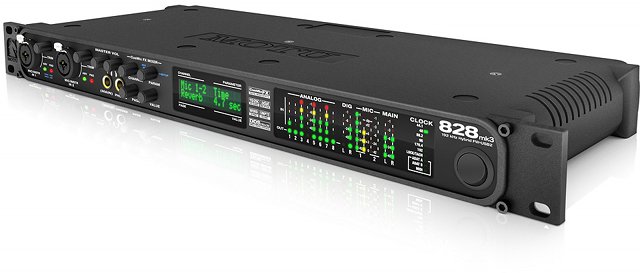
FireWire may be getting rare these days, but new hardware proves that doesn’t mean serious external audio interfaces are in any danger. In the latest iteration of its tried-and-true 828 line, MOTU combines both Firewire and USB 2.0 for Mac or PC, and a wide range of features. The MOTU 828mk3 “Hybrid” in a nutshell:
- 28 inputs, 30 outputs. Combo jacks for 1/4″ guitar in, XLR mic. Phantom power, of course.
- Balanced/unbalanced 1/4″ analog ins and outs running at 24-bit/192kHz. Separate main XLR outs with dedicated volume controls on the front panel. (Quick, turn that down!) Two headphone jacks with independent volume controls.
- No channel sharing (the sort that tends to exaggerate those in/out counts) – you get dedicated mic inputs, ADAT optical, S/PDIF digital I/O, headphone output, and mains, all as separate channels. Just to reiterate…
- Dedicated headphone out.
- Hardware sends.
- Onboard mixing: a 28-input, 16-bus digital mixer.
- Onboard effects: extensive reverb, compression (both standard and one that models a vintage compressor), modeled EQ, and Mac/Windows software for editing.
- Instrument tuner.
- Audio analysis tools.
- CueMix gives you multiple monitor mixes, send/return loops with gear, all with zero-latency.
- Surround mixes if you want them, user-defined or quad, 6.1, 7.1.
- Toaster oven, cappuccino machine modeling the legendary Italian bistro model, controllable through cross-platform BreakfastFX(TM) editing software. Kidding.
In all seriousness, the fact that you can do this much with USB 2.0 raises some question in my mind about how much we really need USB3 for audio. But I’ll be interested to see what happens as that spec and available hardware develops.
What you may miss amongst all the specs is an important feature of the 828mk3 – this interface can run both as an audio interface and as a very versatile standalone mixer, complete with those effects and routing options. That makes it an easy investment to justify. As a rack module, it’s still a bit short on convenient front-panel controls – digging into those settings is still easier with software – but then again, that also means it remains compact.
You also get extensive driver support, with native 32-bit and 64-bit drivers for Mac and Windows, superb MIDI support (sample-accurate connections), low-jitter performance thanks to a DSP-driven clock, and extensive time code support – the features that have made MOTU one of the best-loved, grown-up audio interfaces.

(Side note — really, my only complaint is the lack of Linux support for MOTU boxes, though there’s some hope that could change. Developers complained, MOTU a user voluntarily loaned a unit, and there’s been some progress. If you know anything about how to write drivers, ahem… I’m sure just saying that, some folks in Cambridge, MA are rolling their eyes, but hey, it is another tool some of us use to do our job.)
The 828mk3 Hybrid isn’t big news – it’s the latest evolution of a long line of audio interfaces – but that’s why it’s big news. It consistently winds up on a short list of the most versatile, balanced interfaces out there, and from hardware to software, it’s extremely mature gear.
MOTU says pricing will be the same as on the previous 828mk3, which should cause it to land around US$750 street.
828mk3 Product Page [MOTU]